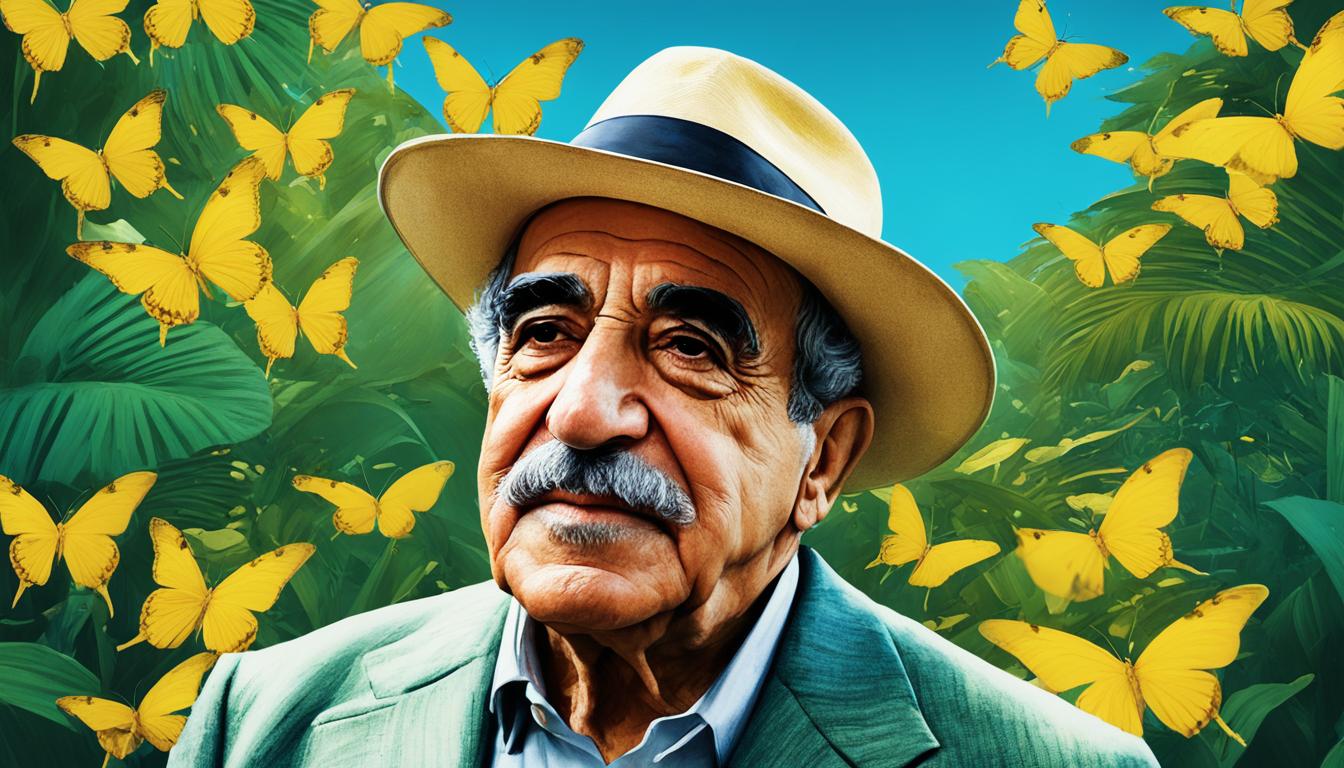Gabriel Garcia Marquez’s “Love in the Time of Cholera” is a must-read for lovers of literary fiction. As a renowned author of magical realism, Marquez weaves a mesmerizing tale of love and passion that spans over five decades.
This article provides a detailed audiobook review of “Love in the Time of Cholera.” We will delve into the plot, characters, and themes of the story. Additionally, we will explore Marquez’s distinctive writing style and evaluate the quality of narration and voice acting in the audiobook.
Key Takeaways
- Gabriel Garcia Marquez’s “Love in the Time of Cholera” is a literary masterpiece that explores love, passion and societal norms
- The audiobook version of the novel offers a captivating narration with well-portrayed characters in a mesmerizing storytelling style
- Readers unfamiliar with Marquez’s work will gain insights into his use of magical realism and lyrical prose
- “Love in the Time of Cholera” is an enduring classic whose significance and impact on the literary world is undeniable
- Overall, this audiobook is highly recommended for its mesmerizing storytelling that transports listeners into the vividly-described world of Marquez’s characters
Overview of “Love in the Time of Cholera”
“Love in the Time of Cholera” is a masterpiece novel written by the renowned Colombian author, Gabriel Garcia Marquez. The novel was first published in Spanish in 1985 and later translated into English by Edith Grossman in 1988. The storyline of the novel revolves around the lovers, Florentino Ariza and Fermina Daza, who fall in love with each other during their youth but are separated due to societal norms. Although Florentino never gives up on his love for Fermina, she marries Dr. Juvenal Urbino, a respected and wealthy doctor. The novel spans over five decades, vividly depicting their love story, societal conflicts, and a historical epidemic of cholera.
The characters in the novel are all explicitly developed, and their emotions are conveyed with a lyrical and poetic quality. Marquez’s use of magical realism is apparent throughout the novel, as he portrays themes of love, passion, aging, and societal norms in a captivating manner. The novel’s central themes are beautifully interwoven and contribute to the overall narrative, making it a must-read for literature enthusiasts.
The brazen romance between the protagonists, coupled with the vivid setting and intricate character development, make “Love in the Time of Cholera” a timeless classic. In the following sections, we will analyze the writing style of Gabriel Garcia Marquez, evaluate the audiobook narration, and elaborate on the themes present in the novel.
Analysis of Gabriel Garcia Marquez’s Writing Style
Gabriel Garcia Marquez’s writing style is an integral part of what makes “Love in the Time of Cholera” such a captivating read. His use of magical realism, a literary device that blends fantastical elements with real-world settings, imbues the story with a dreamlike quality that draws readers into the lives of its characters. This technique is exemplified in the portrayal of the aging Dr. Urbino’s pet parrot, which represents the novel’s themes of love, death, and rebirth.
Additionally, Garcia Marquez’s lyrical prose, marked by its rich descriptions and poetic language, creates a vivid, immersive world that readers can lose themselves in. His sentences flow seamlessly, often spanning multiple paragraphs, lending a rhythm and cadence to the text that is both soothing and evocative.
Overall, Garcia Marquez’s writing style in “Love in the Time of Cholera” is a testament to his mastery of the written word, showcasing his ability to weave a complex, multi-layered story while maintaining a distinct and enchanting narrative voice.
Narration and Voice Acting in the Audiobook
When it comes to audiobooks, narration and voice acting play essential roles in bringing the story to life. In the audiobook version of Gabriel Garcia Marquez’s “Love in the Time of Cholera,” the narrator achieves an excellent balance between capturing the nuances of the text and conveying the emotions inherent in the story.
The voice actor’s tone and pacing are perfectly suited to the novel’s tone, creating a hypnotic atmosphere that draws listeners in. Additionally, the actor’s portrayals of the characters are spot-on, with each having a distinct voice and personality that enhances the audiobook’s immersive experience.
Overall, the narration and voice acting in this audiobook are of high quality, contributing significantly to its success as an adaptation.

Captivating Characterization in “Love in the Time of Cholera”
The characters in “Love in the Time of Cholera” are some of Gabriel Garcia Marquez’s most profound and complex creations. Florentino Ariza, Fermina Daza, and Dr. Juvenal Urbino are all multifaceted individuals with intricate motivations, relationships, and development throughout the story.
Florentino Ariza’s unrequited love for Fermina Daza is central to the narrative, and his enduring passion for her spans over fifty years. His character is defined by his romanticism, persistence, and dedication to preserving his memories of Fermina. Fermina Daza, on the other hand, is initially portrayed as a young woman enamored with societal conventions and expectations. However, through her experiences with Dr. Juvenal Urbino and her own awakening, she transforms into a strong, independent woman with her own voice and desires.
Dr. Juvenal Urbino, Fermina Daza’s husband, is a complex individual whose life work is to combat cholera in the city. He is a man of science who values order and rationality, and his presence in the novel provides a stark contrast to the passionate and impulsive characters of Florentino and Fermina.
The characters in “Love in the Time of Cholera” are memorable not only for their individual traits but also for the intricate web of relationships between them. Whether it’s the jealousy and rivalry between Florentino and Dr. Urbino or the enduring connection between Fermina and Florentino, their interactions add depth and nuance to the story.
The captivating characterization in “Love in the Time of Cholera” is a testament to Gabriel Garcia Marquez’s talent for creating fully realized, three-dimensional characters that feel entirely authentic. Through his masterful storytelling, he invites readers into the hearts and minds of his characters, allowing us to empathize, understand, and connect with their experiences.
Exploring Themes in “Love in the Time of Cholera”
Gabriel Garcia Marquez’s “Love in the Time of Cholera” is a novel that revolves around various themes that contribute to the overall narrative. The author used different themes to draw attention to societal norms and the impacts of love, passion, aging, and more. These themes are significant to readers today as they were when they were first published.
Love and Passion
The novel explores the themes of love and passion in-depth, which go beyond the conventional depiction of romantic love. The story presents passionate love at different stages of life, with all its complexities and contradictions. In particular, the main characters, Florentino Ariza and Fermina Daza, demonstrate an obsessive, destructive, and enigmatic love that evolves over time.
Aging
“Love in the Time of Cholera” also examines the theme of aging and how it affects relationships and perception. The novel illuminates how aging impacts the characters’ perspective on life, notably on love and passion.
Societal norms
Gabriel Garcia Marquez explores societal norms and their effects on people’s lives throughout the story. The author shows how societal norms divide people based on their social class, background, and race, among other things.
The power of memory
Another significant theme in the novel is the power of memory and how it shapes who we are. Florentino Ariza’s character embodies this theme, reminding readers of the potency of memory in preserving and keeping love alive.
In conclusion, Gabriel Garcia Marquez’s “Love in the Time of Cholera” is a richly woven novel that explores various themes that are relevant today. The novel’s themes and characters will linger with readers long after the book is finished, leaving a lasting impression on the heart and mind.
Historical and Cultural Context of the Novel
“Love in the Time of Cholera” is set in an era of political upheaval and social unrest in Colombia, the birthplace of its author Gabriel Garcia Marquez. The novel is heavily influenced by the author’s personal experiences and the historical context of Colombia in the late 19th and early 20th centuries.
One of the key historical events that informs the novel is the devastating cholera epidemic that swept through Colombia and other countries in the region during the late 1800s. This epidemic is the basis for the title of the novel and is a critical backdrop for understanding the societal norms and expectations that influence the novel’s characters. The contrast between the illness that ravages the town and the passions that consume the characters serves to highlight the tension between love and disease, passion and social responsibility.
The novel also explores the class and racial divides that were prevalent in Colombian society at the time. Marquez examines the weight of societal expectations and the impact of strict social norms on individual lives. Through the development of his characters, Marquez paints a vivid picture of the struggles, aspirations, and traditions of those living in Colombia during this historic period.
The Booming Banana Industry
Colombia’s role as a major banana grower is another critical backdrop for the events in “Love in the Time of Cholera.” During the time period of the novel, the banana industry was thriving, and Colombia was a significant producer and exporter of the fruit. However, the success of the industry was a double-edged sword, as it contributed to the continued exploitation of workers and furthered the country’s dependence on foreign powers. The novel examines these themes of exploitation and dependency, and highlights the challenges of living in a country that is at once prosperous and unequal.
Overall, “Love in the Time of Cholera” is a rich and thought-provoking novel that provides a glimpse into the historical and cultural context of Colombia in the late 19th and early 20th centuries. By exploring the themes of love, class, disease, and societal norms, Marquez creates a rich tapestry that reflects the beauty and complexities of life in Colombia during this time.
Comparison to Other Works by Gabriel Garcia Marquez
It is impossible to discuss “Love in the Time of Cholera” without referencing the other notable works by Gabriel Garcia Marquez. One of his most famous novels, “One Hundred Years of Solitude,” shares some similarities with “Love in the Time of Cholera” in terms of themes and writing style. Both books explore the surreal and magical nature of life in small towns and present complex, multi-generational family sagas that span decades.
Another work that can be compared to “Love in the Time of Cholera” is “Chronicle of a Death Foretold.” In contrast to the former, this book is a tense and suspenseful exploration of how small misunderstandings can spiral into disastrous consequences. Both narratives, however, showcase Marquez’s skill in crafting vivid characters and captivating storytelling.
Overall, while “Love in the Time of Cholera” stands apart as a unique and mesmerizing exploration of love and aging, it is clear that Gabriel Garcia Marquez’s other works exhibit similar mastery in themes and writing technique.
Reception and Legacy of “Love in the Time of Cholera”
Since its publication in 1985, “Love in the Time of Cholera” has received widespread acclaim from literary critics and readers alike. Gabriel Garcia Marquez’s masterful storytelling and poignant exploration of love and aging have secured its place as a timeless classic.
The novel won the Nobel Prize in Literature in 1982, solidifying Garcia Marquez’s status as a literary giant.
Over the years, “Love in the Time of Cholera” has been translated into numerous languages and adapted for the screen. The book continues to captivate new audiences, with its enduring legacy impacting literature and popular culture.
Conclusion
After evaluating Gabriel Garcia Marquez’s “Love in the Time of Cholera” in depth, we can confidently say that it is a literary masterpiece that deserves all the critical acclaim and popularity it has received over the years. The audiobook review of this novel has helped us appreciate the captivating storytelling, mesmerizing writing style and rich thematic exploration in a new light.
As we exit the world of Fermina Daza, Florentino Ariza, and Dr. Juvenal Urbino, we cannot help but feel a sense of awe and admiration for the author’s ability to craft a narrative that transcends time and culture. The characters are vividly portrayed, the themes are thoughtfully explored, and the writing style is uniquely captivating.
Whether you experience “Love in the Time of Cholera” through the audiobook or its written form, you are sure to be transported to a world of passion, love, and societal norms. This novel will ignite your passion for literature and leave you yearning for more works by Gabriel Garcia Marquez.



